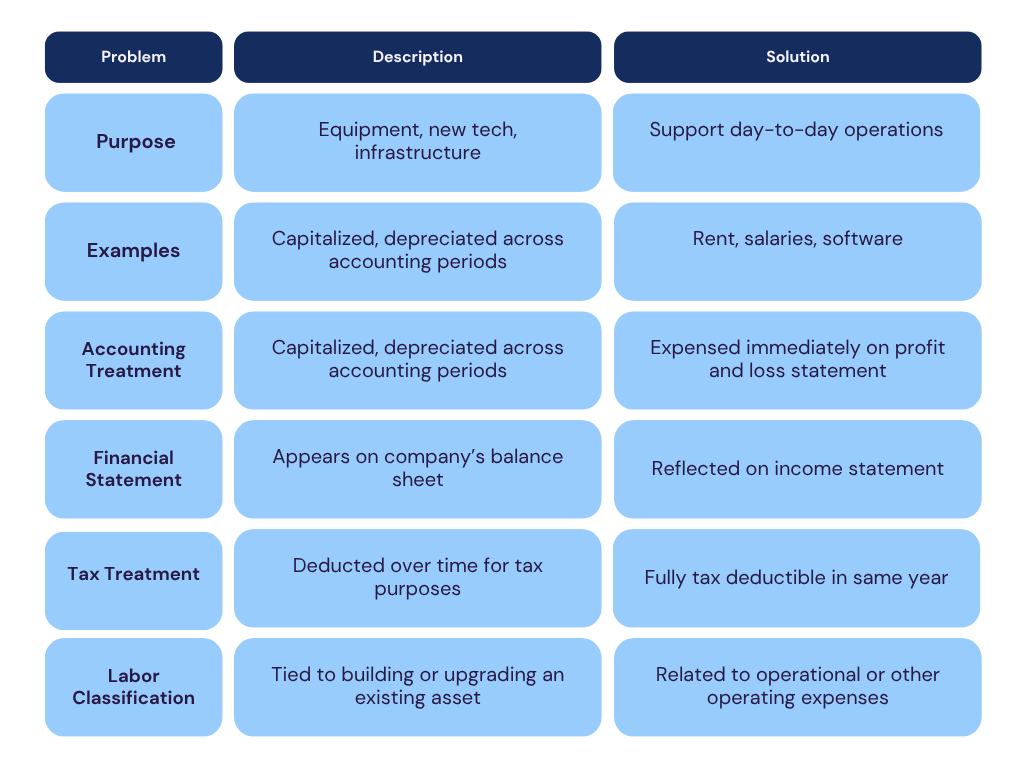CapEx vs. OpEx: A Time-Tracking Perspective for Smarter Financial Strategy
Table of Contents
Every company incurs ongoing costs to operate—but not all business expenses affect your financial strategy the same way. Some are capital expenditures (CapEx): large, strategic capital investments in capital assets that yield long term value. A capital expense refers specifically to the significant financial outlay for acquiring or upgrading long-term assets. Others are operating expenses (OpEx): the recurring costs of running your day-to-day operations. The key difference between CapEx vs. OpEx lies in their accounting treatment, tax deductibility, and impact on your company’s financial statements. Proper classification ensures both CapEx and OpEx are accurately reported on the company’s financial statements.
But there’s a hidden driver most businesses overlook: labor tracking. The ability to track, classify, and allocate labor costs precisely across CapEx and OpEx categories is critical to cost control, operational efficiency, and effective financial planning. Operating expenses (OpEx) cover the costs necessary for maintaining the business’s core operations.
Introduction to Capital Expenditures (CapEx) and Fixed Assets
Capital expenditures are the funds a company invests in physical assets, intangible assets, or capital expenses like software development, infrastructure, or an office building. These capital expenditures (CapEx) purchases are recorded on the company’s balance sheet as fixed assets or long-term assets and are depreciated over their useful life, rather than being expensed immediately. Capital expenses do not appear directly on the company’s income statement; instead, they are allocated over time through depreciation.
Whether you’re investing in a new R&D facility or upgrading systems, CapEx investments are essential to growth and yield benefits over the long term. Yet many organizations struggle to allocate labor to these CapEx projects accurately. Misclassifying them as operating costs can distort both financial visibility and tax benefits.
ClickTime solves this by making it easy to assign labor to capital expenditures CapEx through custom fields and audit-ready time records. If you need to convert part time to full time or understand employee costs, try our FTE calculator.
Capital expenditures are also reflected as investing activities in the cash flow statement, highlighting their impact on a company’s cash flow reporting.
Understanding Operating Expenses (OpEx)
Operating expenses, also known as OpEx expenses, encompass employee salaries, rent, utilities, software subscriptions, and property taxes. Additional examples of operating expenses are office supplies, utility costs, lease payments, and travel expenses. These costs are grouped into specific expense categories, such as payroll, office supplies, and utilities, for better financial management and reporting. Operating expenses include all costs incurred and expenses incurred in the course of operational activities necessary to maintain and run the business. OpEx covers costs related to normal business operations, but excludes non-operating or capital expenses. Fixed cost items, such as rent, insurance, and lease payments, remain constant regardless of production levels, while variable cost or variable costs, such as raw materials and sales commissions, fluctuate with business activity. Raw materials are a variable cost directly involved in production and are typically not classified as OpEx, but as part of the cost of goods sold. OpEx covers the costs of operational activities and operational expenditure necessary to generate revenue. It is important to distinguish OpEx from non operating expenses, such as interest expenses and interest payments, which are not part of the business’s core operations.
Unlike CapEx, OpEx is tied to recurring expenses and provides immediate expense recognition. To improve profitability and generate more free cash flow, businesses should proactively control costs and monitor operating expenses. However, without proper labor tracking, teams may misclassify capitalizable work as OpEx, missing out on important tax deductions.
CapEx vs. OpEx: Why Labor Classification Matters
The timing of expense recognition for both CapEx and OpEx depends on the accounting period, which determines how these expenses are reported on financial statements.
Common Challenges in CapEx/OpEx Tracking
-
Misclassified labor costs can inflate operational costs and reduce capital recovery.
-
Spreadsheets lack granularity needed for compliant labor allocations.
-
Inaccurate classification distorts net income, cash flow, and financial planning.
-
Poor visibility limits forecasting and hinders investment in long term investments.
Cash Flow Management: The Hidden Impact of Time Allocation
Effective cash flow management is the backbone of a company’s financial health, and understanding the distinction between capital expenditures and operating expenses is essential for making the most of your resources. Capital expenditures, such as investments in fixed assets like property, plant, and equipment (PP&E), often represent significant outlays that occur less frequently but can dramatically impact your cash flow. These capital investments are crucial for future growth, but their timing and scale require careful planning to avoid straining liquidity.
In contrast, operating expenses—covering the costs of day to day operations like salaries, rent, and utilities—are more predictable and recur regularly. While each individual operating expense may be smaller than a major capital expenditure, their cumulative effect on cash flow can be substantial, especially if not closely monitored. Balancing CapEx and OpEx is key: allocating time and resources accurately ensures that operational expenditures don’t erode the funds needed for strategic capital projects.
Forecasting plays a pivotal role in this process. By projecting future cash inflows and outflows, businesses can anticipate periods of tight liquidity and plan accordingly. Tools such as cash flow statements and modern accounting software provide real-time visibility into where money is being spent, helping identify trends and areas for improvement. This data-driven approach allows companies to adjust their CapEx and OpEx allocations proactively, rather than reacting to cash shortfalls after the fact.
To further optimize cash flow, businesses can implement strategies to reduce operating expenses—streamlining workflows, renegotiating supplier contracts, or investing in energy-efficient equipment. These efforts not only lower operational expenditures but also free up cash for capital investments that drive long-term value.
By making cash flow management a priority and leveraging accurate time allocation between capital expenditures and operating expenses, companies can maintain financial flexibility, support ongoing growth, and stay ahead in a competitive marketplace.
How ClickTime Solves It
ClickTime gives finance and operations teams the tools to:
-
Use custom fields to identify tangible assets vs. intangible assets
-
Track labor by CapEx vs. OpEx status with one click
-
Visualize labor spend by department, cost center, and task
-
Generate audit-ready reports for external compliance and tax liability defense
-
Ensure clarity around overhead costs and investment drivers
From Compliance to Competitive Advantage
When labor costs are tracked with the same precision as material costs, companies gain:
-
Stronger tax benefits and reduced audit risk
-
Insight into which CapEx assets generate ROI
-
Accurate comparisons between recurring costs and one-time capital investments
-
Data to show how labor helps generate revenue or yield long term benefits
ClickTime makes this possible without disrupting teams. Finance gets better reports; staff get simple timesheets.
Conclusion: Turn Time Into Strategic Insight
Whether you’re tracking spend on an office building or reconciling prior period labor, ClickTime ensures that time entries are correctly attributed for accounting, planning, and compliance. That means:
-
Better visibility into business benefits
-
Accurate financial statements and tax deductibility
-
Fewer errors in capital expenditures vs. operational expenditures
-
Smarter investment decisions
CapEx vs. OpEx isn’t just a finance issue. It’s a strategic lever. With ClickTime, your time data fuels smarter, cleaner, and more compliant business outcomes.







